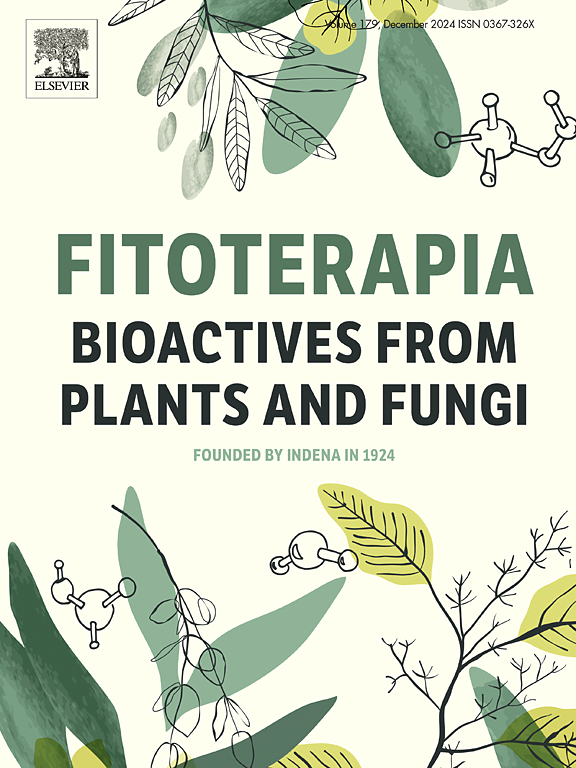开心散生物活性成分通过调节钙信号通路缓解慢速心律失常:综合UPLC-Q-TOF/MS、网络药理学和实验验证
IF 2.6
3区 医学
Q3 CHEMISTRY, MEDICINAL
引用次数: 0
摘要
开心散(KXS)是一种中药方剂,具有治疗慢速心律失常(BA)的潜力,但其有效成分和药理机制尚不明确。本研究采用UPLC-Q-TOF/MS、网络药理学、分子对接、实验验证相结合的方法,对KXS的生物活性成分及潜在作用机制进行研究。共鉴定出23种具有代表性的化合物,包括皂苷、类黄酮、苯丙素、有机酸和木脂素。网络药理学分析显示钙信号通路是参与KXS抗心律失常作用的关键途径,CACNA1C和CAMKIIδ被预测为主要靶点。分子对接和动力学模拟证实了KXS化合物与这些核心蛋白具有很强的结合亲和力。在心得安诱导的BA大鼠模型中,KXS可显著改善心脏传导,调节心率,减轻心肌损伤。进一步的实验结果证实KXS下调心肌组织CACNA1C和CAMKIIδ的表达,提示其在调节细胞内钙稳态中的作用。综上所述,KXS可能通过调节钙信号通路来缓解大鼠慢速心律失常。本研究突出了KXS的多组分、多靶点特性,为其在BA治疗中的应用提供了科学依据。本文章由计算机程序翻译,如有差异,请以英文原文为准。

Bioactive components from Kaixin san alleviate bradyarrhythmia via modulation of the calcium signaling pathway: Integrated UPLC-Q-TOF/MS, network pharmacology, and experimental validation
Kaixin San (KXS), a traditional Chinese medicine formula, has shown therapeutic potential in treating bradyarrhythmia (BA), yet its active constituents and pharmacological mechanisms remain insufficiently defined. In this study, an integrated approach combining UPLC-Q-TOF/MS, network pharmacology, molecular docking, and experimental validation was employed to investigate the bioactive compounds and potential mechanisms of KXS. A total of 23 representative compounds were identified, including saponins, flavonoids, phenylpropanoids, organic acids, and lignans. Network pharmacology analysis revealed calcium signaling as a key pathway implicated in the anti-arrhythmic effect of KXS, with CACNA1C and CAMKIIδ predicted as major targets. Molecular docking and dynamics simulation confirmed strong binding affinity between KXS compounds and these core proteins. In a propranolol-induced BA rat model, KXS significantly improved cardiac conduction, modulated heart rate, and attenuated myocardial injury. Further experimental results confirmed that KXS downregulated the expression of CACNA1C and CAMKIIδ in myocardial tissue, suggesting its role in regulating intracellular calcium homeostasis. In conclusion, KXS alleviates bradyarrhythmia in rats, potentially by modulating calcium signaling pathways. This study highlights the multi-component and multi-target nature of KXS and provides a scientific basis for its application in BA treatment.
求助全文
通过发布文献求助,成功后即可免费获取论文全文。
去求助
来源期刊

Fitoterapia
医学-药学
CiteScore
5.80
自引率
2.90%
发文量
198
审稿时长
1.5 months
期刊介绍:
Fitoterapia is a Journal dedicated to medicinal plants and to bioactive natural products of plant origin. It publishes original contributions in seven major areas:
1. Characterization of active ingredients of medicinal plants
2. Development of standardization method for bioactive plant extracts and natural products
3. Identification of bioactivity in plant extracts
4. Identification of targets and mechanism of activity of plant extracts
5. Production and genomic characterization of medicinal plants biomass
6. Chemistry and biochemistry of bioactive natural products of plant origin
7. Critical reviews of the historical, clinical and legal status of medicinal plants, and accounts on topical issues.
 求助内容:
求助内容: 应助结果提醒方式:
应助结果提醒方式:


